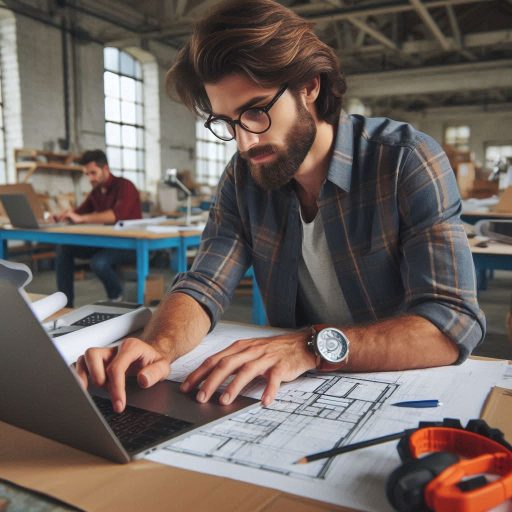Introduction
Industrial design focuses on creating functional, aesthetically pleasing products that enhance user experience.
It integrates art, engineering, and ergonomics.
This field plays a crucial role across various industries, from consumer electronics to furniture and medical devices.
Industrial designers ensure that products are both practical and visually appealing, meeting user needs and market demands.
Their work impacts everyday life, shaping the functionality and aesthetics of the items we use daily.
History of Industrial Design and Its Evolution
Industrial design has a rich history, evolving significantly over time.
It began during the Industrial Revolution, with designers focusing on improving mass-produced goods.
Early industrial design emphasized functionality and efficiency in manufacturing.
As the 20th century progressed, designers began to prioritize aesthetics alongside functionality, reflecting changing consumer preferences.
The rise of technology and digital tools in recent decades has further transformed the field.
Today, industrial design incorporates advanced materials, sustainable practices, and user-centered approaches.
The evolution of industrial design mirrors broader technological and cultural shifts, continually adapting to new challenges and opportunities.
The current state of industrial design
Trends and Advancements in Industrial Design Today
Industrial design is rapidly evolving with several key trends shaping its future.
Today‘s designs increasingly prioritize sustainability and eco-friendliness.
Designers are integrating recycled materials and creating products with minimal environmental impact.
There is also a strong focus on user-centered design, emphasizing functionality and user experience.
Innovations in ergonomic design aim to enhance comfort and usability.
Advancements in manufacturing technologies, such as 3D printing and CNC machining, are transforming how products are made.
These technologies allow for rapid prototyping and customization, leading to more efficient design processes.
Additionally, the rise of smart products and IoT integration is redefining how industrial designs interact with users and their environments.
The emphasis on minimalism and aesthetic simplicity continues to influence design trends.
Clean lines, functional forms, and the reduction of unnecessary elements are popular in contemporary designs.
These trends reflect a desire for both elegance and practicality in everyday products.
Role of Technology in Shaping the Future of Industrial Design
Technology plays a crucial role in shaping the future of industrial design.
Advanced design software enables designers to create and test prototypes virtually before physical production.
Tools like CAD (Computer-Aided Design) and VR (Virtual Reality) facilitate detailed visualization and user experience testing.
Artificial intelligence (AI) is becoming an integral part of the design process.
AI algorithms can analyze user data to predict trends and optimize designs based on real-time feedback.
This technology streamlines design workflows and enhances decision-making.
Moreover, automation in manufacturing is driving innovation.
Automated production lines increase efficiency and precision, allowing for complex designs to be realized with greater accuracy.
Robotics and automation also enable customization at scale, meeting diverse consumer needs more effectively.
Key Players and Companies Leading the Way in Innovative Designs
Several key players and companies are leading the way in innovative industrial design.
Apple remains a prominent force, consistently pushing the boundaries of product design with its sleek, user-centric products.
The company’s focus on integrating advanced technology with minimalist design sets a high standard in the industry.
Companies like Tesla are revolutionizing industrial design with their emphasis on sustainable technology and cutting-edge engineering.
Tesla‘s designs for electric vehicles and energy solutions demonstrate how technology and innovation can drive sustainability.
Design firms such as IDEO and Frog Design are also at the forefront of industrial design innovation.
These firms are known for their human-centered design approaches and their role in shaping the future of consumer products.
Their work emphasizes creativity, problem-solving, and the integration of emerging technologies.
The future of industrial design is being shaped by current trends and technological advancements.
Sustainability, user-centered design, and manufacturing technologies are driving innovation.
Technology, including AI and automation, is enhancing design processes and product functionality.
Leading companies like Apple, Tesla, IDEO, and Frog Design are setting the pace with their groundbreaking work.
As these trends continue to evolve, industrial design will increasingly reflect advancements in technology and a commitment to better user experiences.
Read: Collaborating with Other Creative Roles
Challenges facing industrial design
Sustainability and Environmentally Friendly Designs
The future of industrial design increasingly focuses on sustainability and environmentally friendly practices.
Designers are prioritizing eco-friendly materials and processes to reduce environmental impact.
This shift is driven by growing consumer demand for sustainable products and stricter environmental regulations.
Designers are now exploring renewable materials like bamboo, recycled plastics, and biodegradable substances.
These materials not only minimize waste but also reduce the carbon footprint of products.
Additionally, innovative design strategies, such as modularity and upgradability, help extend the lifecycle of products and reduce the need for frequent replacements.
Energy-efficient manufacturing processes and sustainable packaging are also gaining prominence.
Designers are incorporating energy-saving technologies and reducing packaging waste to further enhance product sustainability.
Embracing circular economy principles, where products are designed for reuse and recycling, is becoming a standard practice in the industry.
Impact of Globalization on Design Trends and Practices
Globalization has a profound impact on industrial design trends and practices.
The interconnectedness of markets and cultures influences design aesthetics, functionality, and user preferences.
Designers are now drawing inspiration from diverse cultures and global trends, leading to more innovative and varied design solutions.
The access to international markets also means that designers must consider global standards and regulations.
Products need to meet different safety, usability, and environmental requirements across various countries.
This necessitates a more comprehensive approach to design that accommodates diverse regulatory frameworks and cultural expectations.
Moreover, globalization facilitates collaboration across borders.
Designers often work with teams and clients from different countries, bringing together a wide range of perspectives and expertise.
This cross-cultural collaboration enhances creativity and results in more inclusive and innovative designs.
Need for Diversity and Inclusivity in Industrial Design
Diversity and inclusivity are becoming essential considerations in the future of industrial design.
Designers are increasingly recognizing the importance of creating products that serve a diverse population.
Inclusive design ensures that products are accessible and functional for people of all abilities, ages, and backgrounds.
Incorporating diverse perspectives into the design process leads to more innovative solutions that address a wider range of needs.
For example, designing products with adjustable features can accommodate different body types and abilities, making them more user-friendly for everyone.
Additionally, considering diverse cultural preferences helps create products that resonate with a global audience.
The push for diversity also extends to the design workforce itself.
A diverse team brings varied viewpoints and experiences, enhancing the design process and fostering creativity.
Companies are striving to build more inclusive teams and create environments where all voices are heard and valued.
In conclusion, the future of industrial design is shaped by sustainability, globalization, and diversity.
Addressing environmental concerns through eco-friendly designs, adapting to global trends, and ensuring inclusivity are critical for advancing the industry.
By embracing these elements, industrial designers can create products that are not only innovative but also responsible and inclusive.
Read: Famous Costume Designers in Hollywood
Opportunities for growth in industrial design
The Potential for Incorporating AI and Machine Learning in Design Processes
AI and machine learning are revolutionizing industrial design processes.
These technologies offer advanced tools for analyzing design data and predicting trends.
AI can automate repetitive tasks, allowing designers to focus on more creative aspects.
Machine learning algorithms can analyze user feedback to optimize product designs and improve functionality.
AI-driven design software can generate multiple design iterations quickly, exploring possibilities that might not be immediately apparent.
This capability speeds up the design process and enhances innovation.
Machine learning also helps in predicting design trends by analyzing large datasets from various sources.
Integration of AI into design processes improves efficiency and accuracy.
For instance, AI can assist in material selection by predicting how different materials will perform in various conditions.
This predictive capability helps designers make informed decisions, reducing the need for extensive testing.
Importance of User-Centered Design and the Rise of Experience Design
User-centered design remains crucial in the future of industrial design.
Prioritizing user needs ensures that products are functional, intuitive, and engaging.
Designers must focus on creating solutions that enhance the overall user experience, addressing both practical and emotional aspects.
Experience design is gaining prominence, emphasizing the importance of designing for the entire user journey.
This approach considers how users interact with products over time, from initial use to long-term engagement.
By focusing on experience design, industrial designers create more holistic and satisfying user experiences.
Designing with empathy and understanding user behavior helps in developing products that resonate with users.
This focus on user experience leads to more successful and impactful designs.
It also fosters user loyalty and positive brand perceptions.
Emerging Markets and Industries Where Industrial Design Can Make an Impact
Several emerging markets offer significant opportunities for industrial design.
The renewable energy sector is one example where design innovation can drive progress.
Designers can create efficient and aesthetically pleasing products for solar and wind energy applications.
The health tech industry is another area ripe for industrial design influence.
Designing user-friendly medical devices and health monitoring tools enhances patient care and simplifies medical procedures.
Innovations in this sector can improve overall health outcomes and user experiences.
Smart home technology presents opportunities for integrating industrial design with advanced technology.
Designers can develop intuitive interfaces and aesthetically pleasing products that enhance home automation and connectivity.
This market is expanding rapidly, with increasing demand for stylish and functional smart home solutions.
In summary, the future of industrial design involves integrating AI and machine learning to enhance design processes.
Emphasizing user-centered and experience design ensures products meet users’ needs and preferences.
Emerging markets such as renewable energy, health tech, and smart home technology offer significant opportunities for impactful design innovations.
Read: Essential Skills for Aspiring Costume Designers

You Might Also Like: Sign Making Workshops and Courses
You Might Also Like: How to Handle Client Feedback as a Storyboard Artist
You Might Also Like: Creative Director: The Art of Visual Storytelling
Collaboration and interdisciplinary approaches in industrial design
Benefits of Collaborating with Other Professionals
Collaborating with engineers, marketers, and psychologists offers significant benefits in industrial design.
Engineers bring technical expertise that enhances product functionality and feasibility.
Their knowledge helps transform innovative ideas into practical designs.
Marketers provide insights into market trends and consumer behavior, guiding the development of products that meet customer needs.
Psychologists contribute an understanding of human behavior, improving user experience and ergonomics.
Effective collaboration ensures that all aspects of a product, from technical performance to market appeal, are addressed.
It allows designers to integrate diverse perspectives and expertise into their projects.
This multidisciplinary approach often leads to more innovative and user-centric designs.
By working together, professionals can tackle complex challenges and achieve solutions that might not be possible individually.
Potential for Cross-Disciplinary Innovation and Creativity
Cross-disciplinary collaboration fosters innovation and creativity in design projects.
Bringing together different fields of expertise can lead to groundbreaking ideas and solutions.
For instance, integrating insights from psychology with design can result in products that better meet user needs and improve interaction.
Cross-disciplinary teams can explore unconventional approaches and challenge traditional design boundaries.
Engineers can introduce new technologies, while marketers can identify emerging trends, creating opportunities for unique and innovative products.
This blend of knowledge and skills often leads to novel solutions and creative breakthroughs that push the boundaries of conventional design.
Innovative designs often emerge from the synergy of diverse perspectives and skills.
Collaboration encourages the exchange of ideas and the exploration of new possibilities.
It allows for the integration of various methodologies and approaches, resulting in more comprehensive and effective design solutions.
Importance of Diversity in Design Teams
Diversity in design teams is crucial for fostering creativity and innovation.
Teams composed of individuals from varied backgrounds bring different perspectives and experiences.
This diversity enhances problem-solving and leads to more creative and inclusive designs.
Different viewpoints contribute to a richer understanding of user needs and preferences.
It helps ensure that designs are not limited by a single perspective but consider a wide range of experiences and requirements.
Diverse teams are better equipped to address global markets and diverse user groups.
Incorporating diverse perspectives leads to designs that are more inclusive and relevant to a broader audience.
It helps avoid biases and assumptions that can limit the effectiveness of a product.
By embracing diversity, design teams can create solutions that resonate with a wider range of users and meet varied needs.
In review, collaborating with engineers, marketers, and psychologists offers valuable benefits in industrial design, leading to innovative and user-centric products.
Cross-disciplinary innovation encourages creative breakthroughs and novel solutions.
Diversity in design teams enhances creativity and ensures that products are inclusive and relevant.
These collaborative and diverse approaches are essential for shaping the future of industrial design and addressing the complexities of a global market.
Transform Your Career Today
Unlock a personalized career strategy that drives real results. Get tailored advice and a roadmap designed just for you.
Start NowRead: Top Skills Needed for Art Educators and Instructors
The future of industrial design
Future Trends and Innovations in Industrial Design
The future of industrial design promises exciting trends and innovations.
Advances in technology will drive the next wave of design.
Expect to see increased integration of artificial intelligence (AI) in design processes.
AI will enable more personalized and efficient product development.
Augmented reality (AR) and virtual reality (VR) will revolutionize design visualization.
These technologies will allow designers to create immersive prototypes and simulations.
Additionally, 3D printing will continue to advance, offering new possibilities for rapid prototyping and custom manufacturing.
Smart products and the Internet of Things (IoT) will become more prevalent.
Designers will focus on creating interconnected devices that enhance user experience.
Innovations in materials, such as biodegradable and self-healing materials, will also play a significant role in future designs.
Impact of Consumer Behavior and Preferences
Consumer behavior and preferences will heavily influence future design decisions.
As consumers increasingly value personalization, designers will focus on creating customizable products.
The demand for unique, tailored experiences will drive innovations in modular and adaptable design solutions.
Designs will also reflect changing consumer values, including a focus on health and wellness.
Products that promote well-being and sustainability will gain popularity.
Additionally, the shift towards minimalism and simplicity will continue to influence design aesthetics, with a preference for clean lines and functional forms.
Consumer feedback will play a crucial role in shaping design outcomes.
Designers will use data and insights from user interactions to refine and improve products.
This data-driven approach will ensure that designs align with evolving consumer needs and preferences.
Potential for Sustainability and Ethical Design Practices
Sustainability and ethical design practices will increasingly shape the future of industrial design.
The design community is placing greater emphasis on environmental responsibility.
Designers will explore eco-friendly materials and processes to minimize waste and reduce carbon footprints.
Circular design principles will gain traction, focusing on creating products that can be easily repaired, recycled, or repurposed.
This approach will contribute to a more sustainable lifecycle for products.
Designers will also prioritize ethical manufacturing practices, ensuring fair labor conditions and responsible sourcing.
The integration of sustainability into design practices will not only meet consumer demands but also drive innovation.
Designers will seek out new technologies and methods that support environmental and social goals.
This shift will influence everything from product materials to packaging and production processes.
In the end, the future of industrial design will be shaped by technological innovations, evolving consumer preferences, and a commitment to sustainability.
Designers will embrace new tools and practices to create personalized, eco-friendly, and ethically produced products.
By staying attuned to these trends, industrial designers will continue to push the boundaries of creativity and functionality.
Conclusion
The future of industrial design promises exciting advancements and innovations.
Emerging technologies like AI and 3D printing will revolutionize design processes.
Sustainability will become increasingly important, with a focus on eco-friendly materials and practices.
User-centered design will continue to drive innovation, emphasizing personalized and intuitive solutions.
The integration of smart technologies into everyday products will redefine functionality and user experience.
Staying current with trends and advancements in industrial design is crucial for future success.
It allows designers to anticipate changes and adapt their practices accordingly.
Understanding new technologies and sustainability practices ensures that designs meet contemporary demands and remain relevant.
Keeping up with industry developments helps designers innovate and stay competitive in a rapidly evolving field.
Exploring the future of industrial design involves continuous learning and experimentation.
Engage with emerging technologies and sustainability trends to shape the industry‘s direction.
Contribute to the conversation by sharing ideas, participating in forums, and collaborating with other professionals.
Embrace opportunities to innovate and push boundaries in your design work.
By actively exploring and contributing, you play a role in shaping the future of industrial design.
[E-Books for Sale]
The Big Book of 500 High-Paying Jobs in America: Unlock Your Earning Potential
$19.99 • 500 High-Paying Jobs • 330 pages
Explore 500 high-paying jobs in America and learn how to boost your career, earn more, and achieve success!
See All 500 High-Paying Jobs of this E-Book
1001 Professions Without a Degree: High-Paying American Jobs You Can Start Now
$19.99 • 1001 Professions Without a Degree • 174 pages
Discover 1001 high-paying jobs without a degree! Unlock career tips, skills, and success strategies for just $19.99!




